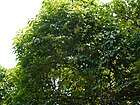Note: This is a project under development. The articles on this wiki are just being initiated and broadly incomplete. You can Help creating new pages.
Difference between revisions of "Embelia ribes - Vidanga"
(→List of Ayurvedic medicine in which the herb is used) |
(→List of Ayurvedic medicine in which the herb is used) |
||
| Line 45: | Line 45: | ||
==List of Ayurvedic medicine in which the herb is used== | ==List of Ayurvedic medicine in which the herb is used== | ||
| − | [[Anu taila]], [[Shadbindu taila]], [[Sanjivani vati]], [[Panchanimbadi vati]], [[Pathyadi lepa]], [[Amritaadi guggulu]], [[Lohaasava]], [[Abhayarishta]], [[Abaana]], [[Amarasundara vati]], [[Avipattikara Churna]], [[Kabjahar]], [[Kalyanaka grita]], [[Kasturibairava ras]], [[Krimikutar ras]], [[Chopachiniyaadi churna]], [[Jatiphaladi churna]], [[Dashamulaarishta]], [[Drakshaarishta]], [[Nintyananda rasa]], [[ | + | [[Anu taila]], [[Shadbindu taila]], [[Sanjivani vati]], [[Panchanimbadi vati]], [[Pathyadi lepa]], [[Amritaadi guggulu]], [[Lohaasava]], [[Abhayarishta]], [[Abaana]], [[Amarasundara vati]], [[Avipattikara Churna]], [[Kabjahar]], [[Kalyanaka grita]], [[Kasturibairava ras]], [[Krimikutar ras]], [[Chopachiniyaadi churna]], [[Jatiphaladi churna]], [[Dashamulaarishta]], [[Drakshaarishta]], [[Nintyananda rasa]], [[Panchatikta Guggulu grita]], [[Mahadrakshaadi Churna]], [[Mahayogaraaja Guggulu]], [[Yogaraja Guggulu]], [[Vidangaarishta]], [[Vidangaasava]]<ref name="Ayurvedic preparations"/> |
==Where to get the saplings== | ==Where to get the saplings== | ||
Revision as of 16:53, 6 November 2023
Embelia Ribes is a scandent shrub or climbing plant producing stems up to 20 metres long. It is widely distributed throughout India. In Ayurveda it is considered widely beneficial in variety of diseases and is also used in homeopathy.
Contents
- 1 Uses
- 2 Parts Used
- 3 Chemical Composition
- 4 Common names
- 5 Properties
- 6 Habit
- 7 Identification
- 8 List of Ayurvedic medicine in which the herb is used
- 9 Where to get the saplings
- 10 Mode of Propagation
- 11 How to plant/cultivate
- 12 Commonly seen growing in areas
- 13 Photo Gallery
- 14 References
- 15 External Links
Uses
Stomachache, Apeworms, Snakebites, Flatulence, Skin eruptions, Dyspepsia, Jaundice, Skin eruptions, Flatulence, Colic, Gas problems.[1]
Parts Used
Chemical Composition
Embelia ribes berries contain several chemical constituents like embelin, volatile oil, fixed oil, resin, tannin, christembine (alkaloid), phenolic acids like caffeic acid[2]
Common names
| Language | Common name |
|---|---|
| Kannada | Amogha, Vayi-vulanga |
| Hindi | Baba-rang, Baberang |
| Malayalam | Tiriitticanni, Tiruvittikanni |
| Tamil | NA |
| Telugu | Potosul, Vaividungalu |
| Marathi | NA |
| Gujarathi | NA |
| Punjabi | NA |
| Kashmiri | NA |
| Sanskrit | Vidanga , Krimighna |
| English | Embelia |
Properties
Reference: Dravya - Substance, Rasa - Taste, Guna - Qualities, Veerya - Potency, Vipaka - Post-digesion effect, Karma - Pharmacological activity, Prabhava - Therepeutics.
Dravya
Rasa
Kashaya (Astringent), Katu (Pungent)
Guna
Laghu (Light), Ruksha (Dry), Tikshna (Sharp)
Veerya
Ushna (Hot)
Vipaka
Katu (Pungent)
Karma
Kapha, Vata
Prabhava
Habit
Identification
Leaf
| Kind | Shape | Feature |
|---|---|---|
| Simple | Coriaceous | Lancelate 6-14cm long and 2-4cm broad, alternating, acuminate entire, perfectly glabours and petiole 1.0 cm -0.8 cm margined |
Flower
| Type | Size | Color and composition | Stamen | More information |
|---|---|---|---|---|
| Unisexual | 4-4 mm | White or yellow | 5 | Smooth, succulent, in dry condition with wrinkles with loss of calyx |
Fruit
| Type | Size | Mass | Appearance | Seeds | More information |
|---|---|---|---|---|---|
| Reddish seed | Enclosed in a brittle pericarp, is covered by a thin membrane | With hooked hairs | Seed is seen covered with light spots |
Other features
List of Ayurvedic medicine in which the herb is used
Anu taila, Shadbindu taila, Sanjivani vati, Panchanimbadi vati, Pathyadi lepa, Amritaadi guggulu, Lohaasava, Abhayarishta, Abaana, Amarasundara vati, Avipattikara Churna, Kabjahar, Kalyanaka grita, Kasturibairava ras, Krimikutar ras, Chopachiniyaadi churna, Jatiphaladi churna, Dashamulaarishta, Drakshaarishta, Nintyananda rasa, Panchatikta Guggulu grita, Mahadrakshaadi Churna, Mahayogaraaja Guggulu, Yogaraja Guggulu, Vidangaarishta, Vidangaasava[4]
Where to get the saplings
Mode of Propagation
How to plant/cultivate
The plant can be grown in variety of soils including light black cotton soil, sandy/rocky in different agro-climatic conditions in tropical regions up to 800-1500m altitude[5]
Commonly seen growing in areas
Central Himalayas, Lower Himalayas, Deccan Ghat, Western Ghats and South India.
Photo Gallery
References
- ↑ 1.0 1.1 ”Karnataka Medicinal Plants Volume-3” by Dr.M. R. Gurudeva, Page No.1147, Published by Divyachandra Prakashana, #6/7, Kaalika Soudha, Balepete cross, Bengaluru
- ↑ Phytochemical Constituents
- ↑ Ayurvedic preparations
- ↑ Plant description
- ↑ Soil and Climate
External Links
- Ayurvedic Herbs known to be helpful to treat Stomachache
- Ayurvedic Herbs known to be helpful to treat Apeworms
- Ayurvedic Herbs known to be helpful to treat Snakebites
- Ayurvedic Herbs known to be helpful to treat Flatulence
- Ayurvedic Herbs known to be helpful to treat Skin eruptions
- Ayurvedic Herbs known to be helpful to treat Dyspepsia
- Ayurvedic Herbs known to be helpful to treat Jaundice
- Ayurvedic Herbs known to be helpful to treat Colic
- Ayurvedic Herbs known to be helpful to treat Gas problems
- Herbs with Leaves used in medicine
- Herbs with Whole herb used in medicine
- Herbs with common name in Kannada
- Herbs with common name in Hindi
- Herbs with common name in Malayalam
- Herbs with common name in Telugu
- Herbs with common name in Sanskrit
- Herbs with common name in English
- Habit - Herb
- Index of Plants which can be propagated by Seeds
- Index of Plants which can be propagated by Cuttings
- Herbs that are commonly seen in the region of Central Himalayas
- Herbs that are commonly seen in the region of Lower Himalayas
- Herbs that are commonly seen in the region of Deccan Ghat
- Herbs that are commonly seen in the region of Western Ghats and South India
- Herbs
- Myrsinaceae








